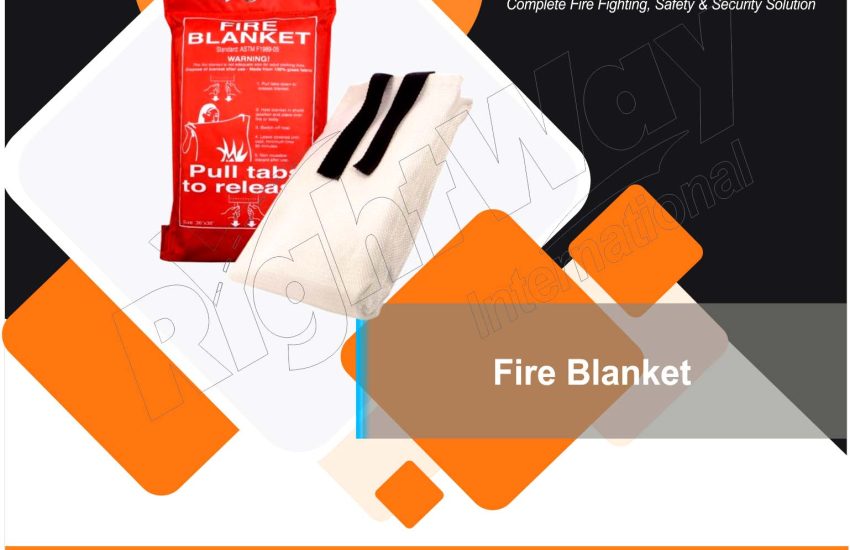Fire Blankets are essential safety devices designed to extinguish small fires and provide protection in emergency situations. They are commonly used in homes, workplaces, and public spaces to control and smother flames, particularly those involving cooking oils, liquids, or small electrical fires. This article explores the importance of fire blanket, their types, key features, and best practices for their use and maintenance.
The Importance of Fire Blankets
Fire blankets play a vital role in fire safety for several reasons:
- Quick Response: Fire blanket can quickly control small fires before they escalate, providing a vital first line of defense in emergencies.
- Versatility: They are effective for a variety of fire scenarios, including grease fires, clothing fires, and small electrical fires, where other extinguishing methods might not be suitable.
- Ease of Use: Fire blankets are simple to deploy and do not require specialized training, making them accessible to everyone.
- No Residue: Unlike chemical fire extinguishers, fire blanket do not leave behind residue, which simplifies cleanup and minimizes damage.
- Personal Protection: Fire blanket can be used to protect individuals from flames, allowing them to escape from dangerous situations.
Types of Fire Blankets
- Standard Fire Blanket:
- Description: Made from materials like fiberglass or wool, these blankets are designed for general fire suppression.
- Benefits: Effective for extinguishing small fires, such as those involving cooking oil or grease.
- Fire Blanket for Electrical Fires:
- Description: Specifically designed to handle fires involving electrical equipment, these blankets are typically rated for use with electrical fires.
- Benefits: Provides protection against electrical fires without the risk of electrical conductivity.
- Fire Blanket for Industrial Use:
- Description: These are larger and more robust, designed for industrial environments where fire risks are higher.
- Benefits: Provides enhanced coverage and durability for industrial applications.
- Fire Blanket for Personal Protection:
- Description: Often designed to be used to cover individuals in case of clothing fires or other personal fire emergencies.
- Benefits: Protects individuals from direct flame contact and allows for safe evacuation.
Key Features of Fire Blankets
- Material:
- Description: Fire blankets are typically made from fire-resistant materials such as fiberglass or specially treated wool.
- Benefits: Ensures that the blanket can withstand high temperatures and effectively smother flames.
- Size:
- Description: Available in various sizes to suit different applications, from small kitchen fires to larger industrial fires.
- Benefits: Larger blankets provide more coverage and are suitable for a range of fire sizes and types.
- Packaging:
- Description: Fire blankets are usually stored in a protective container or wall-mounted cabinet for easy access.
- Benefits: Ensures the blanket remains clean and ready for use while providing quick deployment in an emergency.
- Ease of Deployment:
- Description: Designed for quick and easy use, with clear instructions for deployment.
- Benefits: Allows for rapid response to small fires, reducing the risk of fire spread.
- Durability:
- Description: Fire blankets should be durable enough to withstand multiple uses and remain effective over time.
- Benefits: Ensures long-term reliability and performance in emergency situations.
Best Practices for Using and Maintaining Fire Blankets
- Proper Placement:
- Description: Install fire blankets in easily accessible locations, such as near the kitchen or in high-risk areas.
- Benefits: Ensures quick access during an emergency, improving response time.
- Regular Inspection:
- Description: Check fire blankets periodically for any signs of damage, wear, or contamination.
- Benefits: Ensures that the blanket remains in good condition and ready for use.
- Training:
- Description: Provide training on how to properly deploy and use fire blankets.
- Benefits: Enhances preparedness and ensures effective use during emergencies.
- Clean and Replace:
- Description: Clean the fire blanket according to manufacturer instructions if it becomes contaminated, and replace it if used or damaged.
- Benefits: Maintains the effectiveness of the blanket and ensures safety.
- Follow Manufacturer Guidelines:
- Description: Adhere to the manufacturer’s recommendations for maintenance and replacement.
- Benefits: Ensures that the fire blanket meets safety standards and remains effective.
Conclusion
Fire blanket are a crucial component of fire safety, offering an effective and simple solution for controlling small fires and providing personal protection. By understanding the different types of fire blanket, their key features, and best practices for their use and maintenance, individuals and organizations can enhance their fire safety measures and respond effectively to fire emergencies. Investing in high-quality fire blanket and adhering to proper care protocols not only improves safety but also contributes to a safer environment for everyone.


